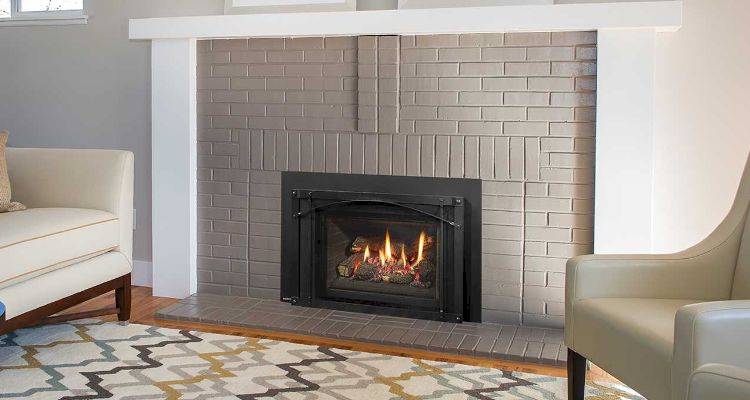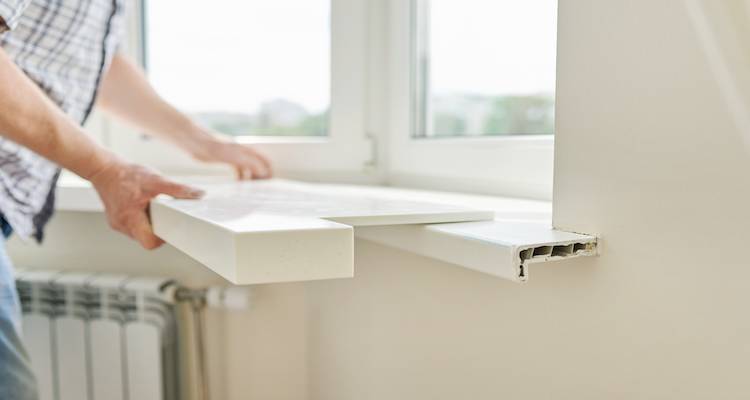Staircase Painting Cost
- The average cost of painting a staircase is around £400.
- The job will usually take around 8 hours.
- A complete pricing breakdown of different types of paint for stairs, including the best paint for stairs.
- How long staircase painting takes and what other decorating jobs you might want to consider at the same time.
- How to find and hire a painter and decorator near you.
Looking for staircase painting costs?
On average, decorators will charge around £400 to paint your staircase, including bannisters and spindles.
Stairs are an essential part of our homes. If you want to spruce up a room with a fresh coat of paint, you should also consider painting your stairway.
Just want a painter and decorator to give you a quote for staircase painting?
We've got you covered. Simply enter some basic project details and decorators near you will reach out with free, no obligation quotes.
To learn about the best paint for staircases first, keep reading.
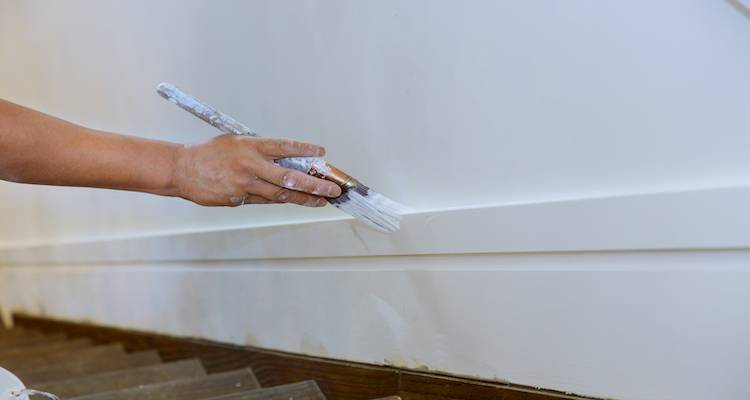
£400
Table of Contents
- How Much Does Staircase Painting Cost?
- Staircase Painting Costs (Supply Only)
- Additional Staircase Painting Costs
- Staircase Painting Labour Costs and Timescales
- Cost Factors of Staircase Painting
- What's Involved in Staircase Painting?
- Can I Paint the Stairs Myself?
- Types of Staircase Paint
- Checklist: Hiring a Painter Near You in the UK
- Sources
How Much Does Staircase Painting Cost?
Do you need your staircase painting?
To paint an average residential staircase, you can expect costs of around £400. However, the cost can quickly add up when painting the structure, depending on the size, type, and staircase design.
For example, a professional stairway painting task such as priming and painting a typical stairwell ranges between £350 and £450, while the price of adding a single colour paint to a stairway with handrails can range from £225 to £700 to prime and paint one staircase.
A professionally painted staircase costs homeowners between £4 and £12 per linear foot. Most stair railings are 5 to 10 feet long and run the length of the staircase.
If a certain type of paint is required, or if the railing has an intricate design that requires small brushes and more time, the cost of the painting project may vary.
For example, painting a wrought iron railing may be more costly than painting a timber railing. If you are painting the railing at the same time as balusters, spindles, and risers, it may be best to leave it until the end so the staircase can be assembled and the task can be finished ahead of time.
I want to restore and renovate my staircase. The staircase rail is still in good condition, it just needs re-decorating. What's the process?
Painting Staircase Prices
Let's take a look at some staircase painting prices to give you an idea of what to expect:
| Job | Cost |
|---|---|
| Paint a staircase with small preparation | £350 - £450 |
| Prime and paint | £400 |
| Adding a single colour paint | £225 - £700 |
| Staircase post | £3 - £17 |
| Professionally painted staircase | £4 - £12 per linear foot |
Staircase Painting Costs (Supply Only)

If you want to give a great first impression in your home, there is no better starting point than in the hallway. A fresh layer of paint on the stairs and bannister is a simple way to update an entrance.
We'll go over the supply costs of painting a staircase in this section. So, if you want to do it yourself, you'll find everything you need right here.
Depending on the brand and the amount needed for the job, the paint for your stairway will cost between £20 and £40.
A sander is also required, and electric sanders are the most helpful way to achieve a sleek, finished look on your woodworking project. Small sander machines finish furniture and craft projects to a high standard, preparing them for painting and refinishing.
When large areas of old paint need to be stripped, you'll want to invest in some effective tools and use a variety of motions to strip surfaces efficiently and quickly. Depending on the quality you want, this will cost you around £18 and £40.
To avoid inhaling fine particles from the supplies you're working with, you'll need to wear a dust mask. Face masks are an important way of staying safe on the job site or at home while doing DIY projects. They are a low-cost, high-efficiency method of ensuring you do not breathe anything hazardous. They range in price from £3 to £23.
Depending on the product, you'll need a paint scraper, which will cost between £4 and £10. Wood filler will cost between £4 and £12.
The right paintbrush or spray gun for the job can make or break the project. A paint sprayer will set you back between £30 and £46, while paintbrushes will set you back between £6 and £15.
Additional Staircase Painting Costs
When having your staircase painted, you might decide that you want to have additional work done to your home at the same time. In this section, we'll go through the additional costs so you know what to expect:
Painting a Room Costs
Painting a room can be a simple task for any painter or decorator, and it is something that any DIY enthusiast can do. But how much does it cost to paint a bedroom? This is almost entirely determined by the size of the room.
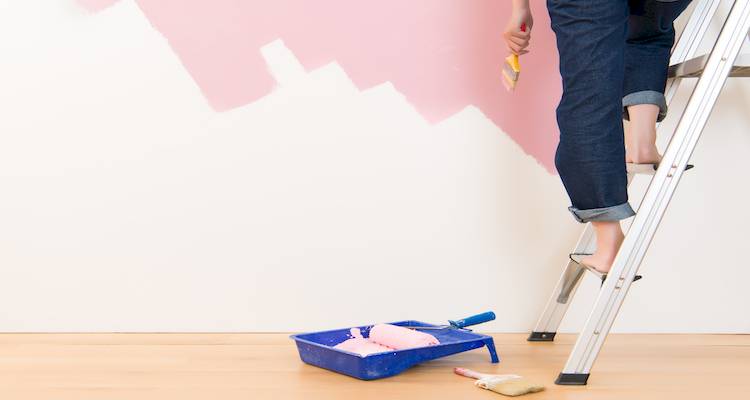
A standard 4m by 3m room would take a couple of days to paint entirely, including woodwork and coving. Outside of London, most decorators charge around £150 to £200 per day, so your total labour cost would be around £300 to £400.
Adding another £50 for the paint, results in a total cost of £400.
Even if you're concerned about the cost, hiring a professional painter is usually the best option. Expert decorators will know precisely how to start preparing the roof, walls, and woodwork before painting them to ensure a smooth finish.
New Staircase Costs
The average cost of a new staircase is around £1,500, which includes the removal of your old one and the complete installation of the new one.
When calculating the cost of constructing a new staircase, consider the following factors: access, project scale and size, and the difficulty of your design.
Each factor can potentially increase or decrease the project's overall cost. As a result, planning for these is critical when deciding how to proceed with the construction.
What's the best wood to use for a newel post? Pine seems a bit too soft.
Painting Skirting Boards Costs
When you've had your staircase re-painted, your existing skirting boards can end up looking a little shabby. With the cost of painting your skirting boards starting a £200, it's a relatively low-cost upgrade that has the potential of making a big impact in your home.
Painting House Exterior
The average cost of painting a two-story, three-bedroom house in the UK is around £850. However, keep in mind that this is only an estimate, and many cost-variable factors will affect the final cost of your project.
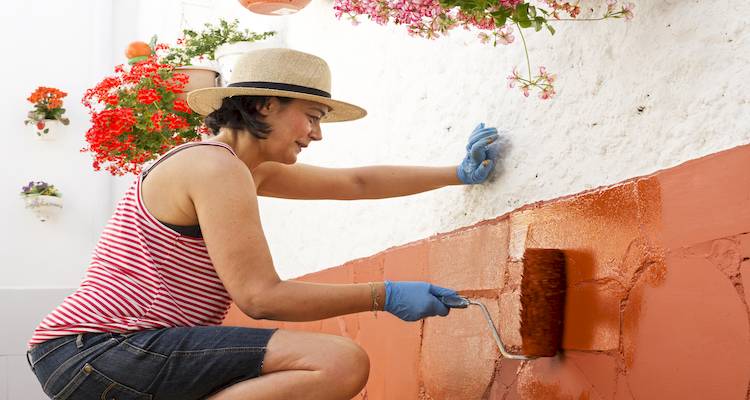
These cost factors include the size of your home, its design, the materials used, and the tradesperson's daily or hourly rates.
When you decide to hire a professional painter to paint the exterior of your home, you usually pay for all materials, supplies, and labour. In most cases, you will need to erect scaffolding before having the exterior of your home painted.
Staircase Painting Labour Costs and Timescales
Since many staircase parts can be painted, this must be factored into the final cost. A painter will usually complete the entire painting job at once to ensure that the stairway looks impressive.
A painter would be unable to offer an accurate quote over the phone. Instead, they must check the existing paintwork and decide whether your home has access issues.
Remember that most painters charge by the hour, so the more items must be painted, the longer it will take the painter to finish the job.
A professional painter can estimate the cost of a job by measuring it and considering all aspects, including the walls, treads, risers, posts, balustrades, spindles, stairways, and ceilings that may or may not need to be painted.
When you hire a painting business, you pay for comprehension, convenience, lower labour costs, and a higher-quality painting job. Hiring a painting contractor to relieve stress is worth the additional painting costs for some people.
A painter's day rate typically ranges between £100 and £300. Smaller painting jobs for staircases typically cost between £15 and £40 per hour.
Tradespeople's daily rates range from about £150 to £300, with fees in London and the South-East occasionally approaching, if not exceeding, the higher amount.
Because paint needs to dry between layers, the paint used may impact how long it takes to complete each room. In more significant works, painters frequently collaborate.
Hiring a single contractor may have appeared to be the cheapest option. This, however, almost always means that the job will take longer, save very little time, and, in some cases, cost more. It takes approximately 8 hours total, spread over four days.
It usually takes two hours to tape the areas around the staircase to protect the rest of the balustrade from unintentional paint drops. Depending on the colour, the staircase requires three coats; your spindles may require less.
Because all that is required is a touch-up, the first coat typically takes three hours, the second layer takes two hours, and the last coat only an hour.
Cost Factors of Staircase Painting
When having your staircase painted, other cost factors could increase the cost you wouldn't expect. This section will go through the different cost factors to know what to expect.
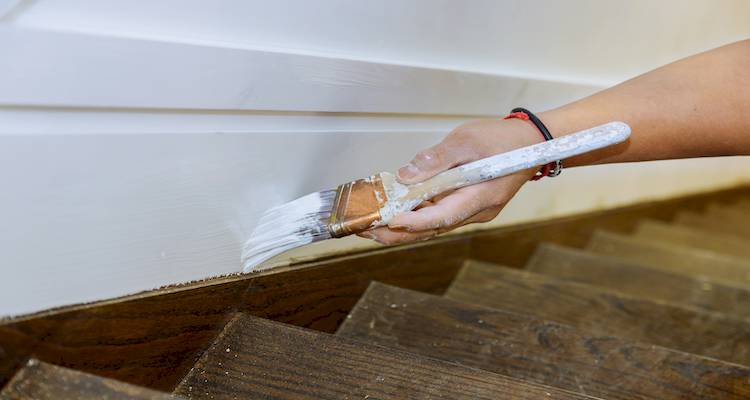
Type of Paint
The type of paint used could significantly impact the cost of the painting work. If you have specific requirements for the paint, you can bring it yourself. For example, do you only use regular paint? It is usually more interesting in this case to let the painter provide this. You will save money in this manner.
Size
Unsurprisingly, the cost of painting a staircase rises with the size of the staircase. Of course, that isn't always the case, but an enormous staircase frequently requires more materials and takes longer to maintain than a smaller staircase. However, this is unlikely to be a significant financial consideration.
Duration
The duration it takes to complete the job may or may not affect the overall cost, and it is primarily determined by how the tradesperson works. In some cases, a contractor will be paid in advance in the form of a lump sum, while in others, they will be paid hourly.
Location
The cost of living in your area and supply and demand levels will influence the prices that individuals or businesses set. Another thing to consider is how fast nearby providers can get to your property. As their route lengthens, gasoline costs will rise, increasing your total payment.
The Minimum Fee
For starters, a painter could charge a small fee. This could be a small fee added to your overall cost or the result of a predetermined labour fee. So, if you charge-free fixed labour for four hours, but the project takes only two hours, this is an extra expense.
What's Involved in Staircase Painting?
Painting a staircase is a simple DIY project that can completely transform your space. Paint ideas are a great, cost-effective way of making tired hallways feel more loved, which is excellent news if you're on a tight budget. We'll walk through the steps of painting a staircase here.
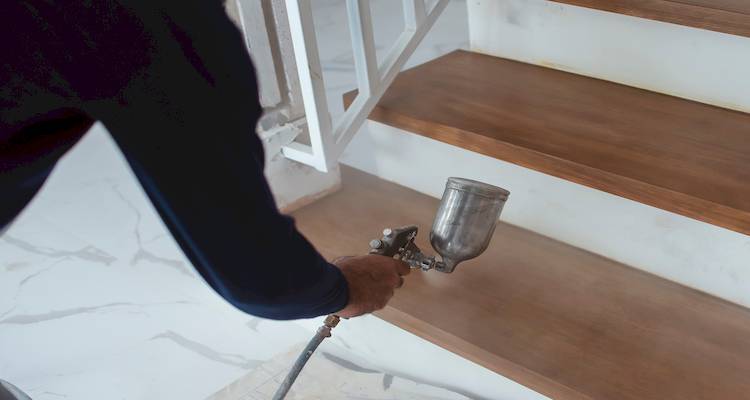
Examine the Surface
Before painting, inspect the railing, balusters, trim, and stair surfaces. Remove and discard any carpeting as needed. If you previously painted your stairs, look for areas where the finish is bumpy, uneven, or peeling.
These are indicators that you should remove the old paint before proceeding. You can simply paint over the existing finish if it appears smooth and in good condition.
Get The Stairwell Ready for Painting
Repair minor flaws with wood filler, such as nail holes, following the company's application and drying time instructions. Next, scuff up the entire surface to be painted with fine-grit sandpaper to help the paint stick.
To remove dirt and build-up, use a degreaser to clean the surface. Remain dry with a clean, lint-free cloth to remove any remaining dust.
The Stair Railing and Trim Should Be Primed And Painted
To avoid walking on freshly painted steps, begin by painting the staircase railing and trim rather than the stairs themselves. Using heavy butcher paper or drop cloths and painters tape, mask off the steps and surrounding areas.
Start from the top of the stairs, and apply primer to the handrail with a 2-inch trim brush. Rep with the stairwell trim and allow the primer to dry.
Begin again at the top of the stairs and paint the handrail and trim with your preferred colour. Working carefully, cover all surfaces evenly with the brush, and finish each part by brushing with the grain. Apply two to three layers, allowing enough time between each layer to dry.
Balusters Should Be Primed and Painted
Mask off the balusters where they meet the steps if you intend to paint them a different colour than the rest of the staircase. Skip the tape if you're painting it the same colour, but keep a dampened cloth nearby to wipe up splatters or drips as you go.
Any paint drops will dry as lumps, giving your paint finish an untidy appearance. As with the rest of the railing, prime and paint the balusters. Then, set it aside to dry.
Alternate Each Step Of The Stairwell To Prime It
Protect or mask any zones around the stairs that you don't want to be painted, including the top and bottom. Then, apply primer to the underside of the first nosing, beginning at the top of the steps.
Brush primer onto the first riser and then the stair tread. Proceed in this order, applying primer after every other step. If you leave alternate steps unpainted, you can use the stairs while the paint dries.
Allow enough time for the first steps to dry before applying primer to the remaining steps.
The Stairs Should Be Painted and Sealed
Rep with the paint, using soft brushstrokes and extending into all edges as you paint each step. Allow the first set of steps to dry completely before painting the alternate steps. Once dry, lightly tape 4-inch squares of cardboard to the decorated steps to remind you which treads are safe to step on.
Next, apply two to three coats, allowing enough time between each layer to dry. Finally, to protect the finish, apply sealer or polyurethane to the steps if desired.
Can I Paint the Stairs Myself?
Stairwells are the areas immediately above or around your home's staircase. They are usually the first area guests enter when entering your home, so making a good impression is critical.
A nicely decorated stairwell with a bright runner up the stairs will make coming home a pleasure. But should you paint the stairs yourself? Here, we will go through why hiring a painter will give you the best result.
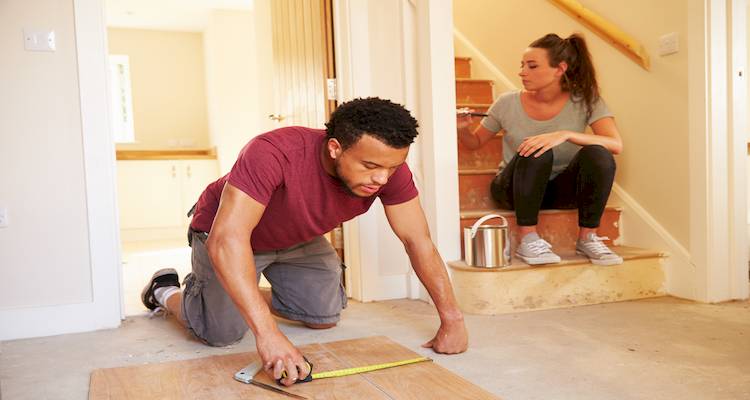
Painting a stairwell is more complex than painting a room. Your stairwells and staircase ideas are frequently double-height – or the full height of the property excluding the loft – and therefore represent the tallest walls and most enormous ceiling you'll ever need to paint inside your home. It is best to hire a professional painter for safety reasons.
Before you or your decorator begins painting, any property with particularly complex or high stairwells, as well as any spanning more than two floors, should have professionally installed scaffolding.
Using a paint roller and extension poles is the most secure way to paint the highest points of your stairwell. It's certainly less dangerous than balancing on wooden beams or ladders.
You can use a good step ladder or platform on the upper floor landing to reach any ceiling, but keep it away from the stairwell.
When reaching a neat line between walls and ceilings, using extension poles can limit precision. Choose a Paint Edger with an extension pole rather than one with a fixed handle. Corner Pads are triangular and can get into corners that a paint roller cannot.
Before you begin, fill any holes and fine cracks and lightly sand the walls before cleaning with sugar soap.
Use a primer first if you're painting over a darker colour. Then, apply the paint with a roller or foam pad to quickly cover large areas, forming a W and overlapping slightly to avoid gaps.
Before you begin, use a paint scuttle or tray with grooves to help prevent overfilling the roller or pad with paint, and practise your technique.
Stairwells lack natural light, resulting in shadowy surfaces and making it difficult to see where you've been with your paint. Set up lamps or lights before you begin in this situation.
Types of Staircase Paint
Painting the staircase is a great way to transform your hallway and an excellent project for untrained DIYers.
Most staircases are made from wood, which gives itself well to painting - but, what are the best paints for stairs? There are some rules to follow when painting your stairs for the first time to ensure that the final product meets your expectations.
Choosing the right paint for your stairs is also essential if you purchase a carpet runner or stair rods or bars to improve the look of your staircase. Nothing beats putting beautiful runners and bars on stairs that have been poorly painted or painted with cheap paint.
Floor paint appears to be the best option for painting the stairs because it is durable, quickly cleaned, stain-resistant, or even a high-quality matt or high-gloss emulsion. Floor paints are available in a variety of colours; choose one that is suitable for wood floors.
It is worthwhile to invest in a good quality brush for your stairs as it will make painting the edges easier and leave fewer brush marks, offering you a better overall finish.
We'll go over the various types of staircase paint and their benefits and drawbacks, so you know what to expect and can decide which paint is best for you!
Slip Resistant Paint
A long-lasting, slip-resistant porch and floor paint are beneficial for stairwells. If you want to use standard latex paint, coat it with many coats of water-based polyurethane to make it last longer.
Oil-based polyurethane lasts much longer, but it yellows with age, takes longer to dry, and contains more chemicals, resulting in more fumes.
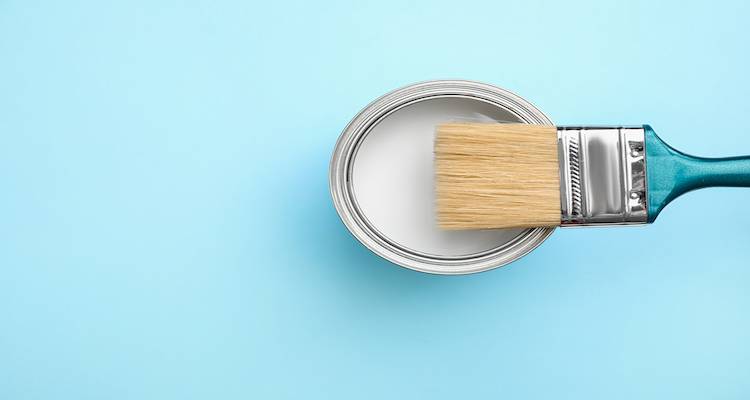
Allow a few days after painting to use your stairs. If you can't wait, complete only the second step that week and the rest the following week; mark the functional treads with painter's tape and be ready to carry any pets or children up and down as needed.
Pros
- ✔ Long-lasting
Cons
- ✖ It takes a long time to complete
- ✖ Additional chemicals
- ✖ It may turn yellow
Gloss Paint
The sheen of the paint is just as important as the colour. High-gloss paint is more washable and sturdier than matte paint, but it highlights flaws. Go with semi-gloss paint if you intend to sand the stairs smoothly and protect them from high-heel scuffs or pet-claw scrapes.
If you aren't utilising floor paint, mix in paint traction rubber grit or sprinkle it on each step between coats. The sand-like rubber feels better on bare feet than other kinds of grit, such as aluminium oxide.
Pros
- ✔ Washable
- ✔ Durable
Cons
- ✖ It can feel gritty at times
Various Coloured Paint
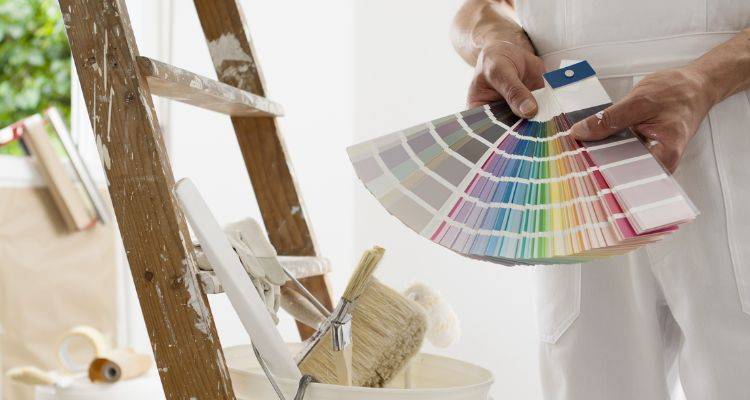
Dark treads conceal wear and dirt, while light risers add visual interest. The railings contain colour cues, such as pairing the stairs to the stairway and the bannisters to spindles.
You can blend open-design stairs into the surroundings by painting them to match the surrounding wall, or you can put an appealing stairway on show in contrasting colours.
If your design decisions include vibrant colours, wildly vivid visual art, or hipster edginess, think of the stairs as a blank canvas. Following the selection of stairway artwork, paint the stairs or risers a complementary base colour.
Set your creative side to work only on the risers, for instance, by acrylic painting or painting text in an appealing font.
Alternatively, use three, four, or more bright colours on the entire stairway to create a flower spiral, geometric "waterfall," or scenic pathway. Then, with stencils and stamps, anyone can become an artist.
Pros
- ✔ The dark colour conceals wear and dirt
- ✔ Brightens the room
Cons
- ✖ Not appropriate for everyone
Checklist: Hiring a Painter Near You in the UK
- Get at least 3 quotes for the entire job and be specific about the work you require, including any preparation, such as patching cracked walls. Get this broken down for large-scale projects so you can easily see what things cost and when they will be completed.
- Don't be shy about asking – can they bring furniture and floor dust covers? Will they relocate the furniture? Can they provide you with references from previous customers?
- Be straightforward about who will offer materials and how much they will cost. To avoid wasting time and money, if you're providing everything, ensure it's all onsite at the start of the job.
- Your friends and family are the best sources of information when hiring a painting company! Ask them for recommendations—if they've had a good experience with someone, they'll be happy to share it with you, and if they've had a bad experience with someone, they'll feel the same way.
- You can also look up online reviews to see what other people are saying about the painters you're thinking about hiring. Examine reviews from multiple sources to get a complete picture, and please read both comments and reviews. When it comes to negative reviews, pay attention to how the business responds to them, as this can reveal how committed they are to making their clients satisfied.
- A great painter will generally have a portfolio of work available for you to review during the onsite estimate, either in the form of a printed book or in digital format. They may have examples of similar work on their website and social media platform feeds, allowing you to delve deeper. Take note of the quality of the work when viewing before and after photos or simply photos of completed jobs.
FAQs
How Do You Paint Staircase Spindles?
How Do You Remove Paint from a Staircase?
What Is the Best Paint for a Staircase?
What Colour Is Best for Stairs?
Is Painting a Staircase Hard for DIY?
Sources
https://interactive.planningportal.co.uk/flat-and-shop/inside-flat-and-shop/decoration/planning-permission
https://www.wow1day.com/blog/interior-painting/how-find-good-painter

